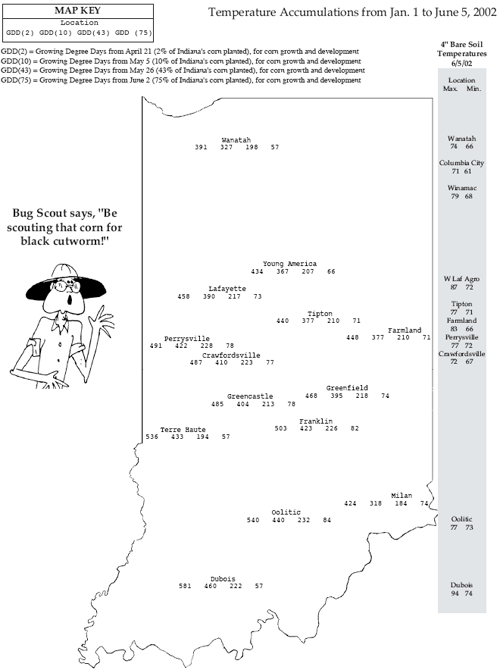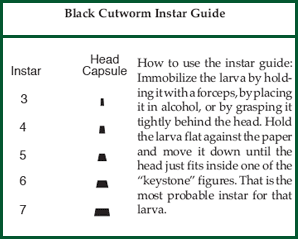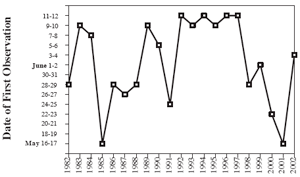Pest & Crop Newsletter
|
||||||||||||||||||||||||||||||||||||||||||||||||||||||||||||||||||||||||||||||||||||||||||||||||||||||||||||||||||||||||||||||||||||||||||||||||||||||||
Black Cutworm Rearing Its Ugly Head- (John Obermeyer, Rich Edwards, and Larry Bledsoe)
Ron Blackwell, IPM Survey Specialist, has been diligent in following up on some of the late black cutworm moth flights into the state. He tracked heat unit accumulations from late April intensive moth captures and then traveled to east central Indiana for field sampling. The following table, “Black Cutworm Larval Survey”, shows that there are cornfields with significant and economic damage. Unfortunately, most pest managers are not scouting because they’re so busy trying to catch up on other field activities. Scout high-risk fields, i.e., weedy before or during planting, by inspecting 20 consecutive plants in each of 5 areas of a field (100 plants) for feeding activity and cutworms. Count and record the number of plants cut or damaged and determine the percentage of plants affected. Also collect black cutworm larvae and determine the average instar stage. While sampling, also record how many leaves are fully unrolled (the collar of the leaf is visible on a fully unrolled leaf). Use the following management guidelines and instar guide for treatment decisions. Suggested foliar insecticides for control of economic infestations are listed below.
Stalk Borer Migrating– (John Obermeyer, Rich Edwards, and Larry Bledsoe)
A phone call from west central Indiana alerted us to the fact that stalk borers are infesting 2 to 3-leaf corn. The small larvae were leaving corn plants with the typical “dead-heart” appearance, i.e., bottom leaves healthy and whorled leaf(ves) wilting. Once the stalk borer has either outgrown or killed one plant, they will then move onto another. Research conducted at Iowa State University had shown that leaf feeding by early instar larvae had an insignificant effect on yield. However, once the stalk borer had tunneled, grain yield reductions were 59% for primary plants (first plant infested) and 74% reductions for secondary plants (second plant infested) sustaining dead-heart damage. The damage obviously intensifies as the larvae increase in size. If corn seedlings are being killed by stalk borers, the application of a insecticide with good residual activity may be beneficial to control the worms as they move from dying plants to new hosts. However, timing of such treatments is critical to increase the probability of success. Spot treatments where damage is prevalent, such as along waterways or where giant ragweed has been a problem, often controls further movement.
Corn Rootworm Hatch is Underway– (John Obermeyer, Larry Bledsoe, and Rich Edwards)
Roots from 4-leaf corn collected on June 4 near Lafayette in Tippecanoe County revealed rootworm larvae. Because of the size of the worms, it is likely that they hatched in late May. Hatch in southern Indiana counties has occurred several days earlier, while hatch in northern counties is just beginning. Depending on soil temperatures, hatch will continue for a while. It is too early to sample corn roots for the presence of larvae, as the worms are inside the roots. In a couple weeks, it will be possible to dig up and inspect for larvae and feeding scars on the roots. More on this in a future issue of Pest&Crop.
|
||||||||||||||||||||||||||||||||||||||||||||||||||||||||||||||||||||||||||||||||||||||||||||||||||||||||||||||||||||||||||||||||||||||||||||||||||||||||
Stratego Fungicide is Labeled for Corn– (Gregory Shaner)
Although foliar fungicides are rarely used on hybrid field corn, they are routinely used on seed corn. Growers of specialty hybrids may also use fungicides when disease pressure is great. Stratego, a relatively new fungicide, has been labeled for use against common rust, eyespot, gray leaf spot, northern corn leaf blight, southern corn leaf blight, and northern corn leaf spot on field corn, field corn grown for seed, and popcorn. Stratego is a combination product. It contains propiconazole (the active ingredient in Tilt) and trifloxystrobin, a member of the strobilurin class of fungicides (the active ingredient in Quadris is a strobilurin). Consult the labels for details about rates, times of application, safety issues, and environmental hazards.
Update on Wheat Leaf Blights– (Gregory Shaner)
Septoria and Stagonospora leaf blights of wheat have been present in Indiana wheat fields for several weeks, but have not become as severe as might have been expected from the abundant rainfall we have experienced. I attribute this to the cool weather that prevailed over much of the state until recently. For the week ending May 26, temperatures throughout the state were running 8 to 10 ?F below normal. However, conditions changed this past week. For the week ending June 2, temperatures were averaging 6 to 7 ?F above normal. The hot weather continued through this past Tuesday. Although temperatures are a bit lower now, they are still within the favorable range for the leaf blight fungi. With the high humidity and rainfall that have accompanied this warm weather, severity of leaf blotch and glume blotch may increase rapidly. Both of these diseases spread up the crop canopy during the season. The lowest leaves are infected first, either in the fall or early in the spring. Spores produced in lesions on these leaves are spread by rain splash to upper leaves. When leaves remain wet for long periods, these spores infect. After a period of incubation, lesions develop. Cool weather reduces the likelihood of infection and extends the incubation period for infections that do take place. The warm weather of the past week will hasten the development of infections that occurred earlier. Where rain fell during the warm weather of the past week, there will be additional infection
|
||||||||||||||||||||||||||||||||||||||||||||||||||||||||||||||||||||||||||||||||||||||||||||||||||||||||||||||||||||||||||||||||||||||||||||||||||||||||
Diagnosing Stand Establishment Problems in Corn– (Bob Nielsen) Stand establishment in corn does not simply refer to the success or failure of germination and emergence. Stand establishment also includes the critical initial formation of the nodal or permanent root system (see my related article on root development).
Until the nodal root system is well established, the corn crop is susceptible to various early season stresses that injure the seed, seed roots, and mesocotyl. These stresses include damage from below-ground insect feeding (wireworm, seedcorn maggot, grub), seedling blights, seed rots, fertilizer injury (starter fertilizer, anhydrous ammonia), excessively dry soils, excessively wet soils, and prying agronomists. The reason that early stress can so severely impact an establishing stand of corn is that corn seedlings depend primarily on the energy reserves of the kernel until the nodal roots are established. These energy reserves are translocated from the kernel through the connecting mesocotyl “pipeline” to the young stalk and leaf tissues. If damage to the mesocotyl or seed occurs prior to substantial nodal root development, seedlings will either die or be severely stunted. Therefore, a healthy kernel, seed roots, and mesocotyl are vital until the nodal roots are well established. As the nodal roots develop, the importance of the seed reserves and the mesocotyl declines. Two of the major interacting factors that influence the extent to which early season stress affects stand establishment are soil temperature and moisture content. Early-planted corn this year (what little of it there was) endured 4 to 5 weeks of sustained cool soils after planting that greatly slowed early corn development of corn seedlings. Much of that time, the soils were also saturated, if not ponded, which further stunted corn development. Whenever early nodal root development is significantly delayed, other stress factors (especially soil insects and diseases) simply have more time in which to damage the seed and mesocotyl and, ultimately, injure or kill young seedlings. Seed quality and the hybrid’s inherent seedling vigor also play an important role in determining the consequence of injury during stand establishment. Otherwise minor stresses during stand establishment can have major effects on overall plant health if seed quality is less than acceptable or if seedling vigor is simply average. The bad news is that if stand establishment this year is crappy (an agronomic term meaning uneven), there is little you can do about it now. As you think about next year, there are a few things you can keep in mind to minimize the future risk of crappy stands.
Corn Root Development– (Bob Nielsen)
Corn is a grass and has a fibrous type root system, as compared to soybeans or alfalfa which have tap root systems. Successful establishment of the corn plant’s root system helps ensure successful establishment of the crop itself. One of the more critical periods for successful root establishment occurs from emergence to about the six-leaf collar stage of development. To better understand rooting development and problems associated with root restrictions, it is important to understand that root development in corn can be characterized by root position relative to the seed. The Seminal (Seed) Root System Seminal roots originate near the seed and are comprised of the radicle and lateral seminal roots. The seminal root system anchors the young plant and absorbs minor amounts of water and nutrients for the first two to three weeks. Seminal roots cease new growth shortly after the coleoptile emerges at the soil surface. A young corn seedling depends primarily on the energy reserves of the kernel until permanent (nodal) roots develop. Within a few days after emergence of the coleoptile and first leaves from the soil, a second root system, the nodal roots, begins to develop from the crown or growing point. If damage occurs to seminal roots or the mesocotyl before nodal roots become established, stunting or death of the plant will occur. Examples of such damage include salt injury from excessive rates of starter fertilizer, seedling blight, herbicide injury and insect feeding damage. Nodal (Or Permanent) Root System Nodal roots begin to elongate from the coleoptile crown shortly after growth stage VE and are distinctly visible by growth stage V1. An individual set of roots forms at each stalk node below-ground plus one or more above-ground nodes. By growth stage V6, the nodal roots have typically become well established and have completely taken over the sustenance of the plant. Four stalk nodes usually comprise the ‘woody’ triangle at the bottom of a corn stalk. The internode above the fourth node elongates about 1/2 inch, above which is found the fifth node (still below or just at the soil surface). Consequently, five sets of nodal roots will usually be detectable below ground (one set for each below ground stalk node). Elongation of the internode above the fifth node ‘pushes’ the sixth node above ground. Continued elongation of subsequent stalk internodes will result in higher and higher placement of the remaining stalk nodes. Additional sets of nodal roots that form at above ground stalk nodes are usually assigned the ‘fancy’ name of brace roots, but are functionally identical to those nodal roots that form below ground. If surface soil conditions are suitable (moist and not excessively hot), brace roots can successfully enter the soil, proliferate and effectively scavenge the upper soil layer for water and nutrients.
End-of-Season Planter Care– (Bob Nielsen)
Uniform seed drop is an important contributor towards the achievement of optimum corn grain yield. Planter maintenance and adjustments are the primary factors that influence the uniformity of seed drop. Given the nightmarishly delayed 2002 planting season, many farmers may simply want to park their planters and forget about them until next winter. Bear in mind, however, that planter maintenance for 2003 begins after the finish of the 2002 planting season. Here are a few pointers to consider. Consult your planter operations manual and equipment dealer for more details.
Useful References Nielsen, RL (Bob). 1994. Planting Speed Effects on Stand Establishment and Grain Yield of Corn (AGRY-94-02) [Online]. Purdue Univ. Agronomy Dept., W. Lafayette, IN. <http://www.agry.purdue.edu/ext/pubs/AGRY-94-02_v2.pdf> (verified 6/1/02). Nielsen, RL (Bob). 2001. Stand Establishment Variability in Corn (AGRY-91-01) [Online]. Purdue Univ. Agronomy Dept., W. Lafayette, IN. <http://www.agry.purdue.edu/ext/pubs/AGRY-91-01_v5.PDF> (verified 6/1/02). Nielsen, RL (Bob). 2002. Corn Planter Tuneups: Why Bother? (A Microsoft Powerpoint presentation) [Online]. Purdue Univ. Agronomy Dept., W. Lafayette, IN. <http://www.agry.purdue.edu/ext/ppt/PSV-2002.ppt> (verified 6/1/02). Don’t forget, this and other timely information about corn can be viewed at the Chat ‘n Chew Café on the World Wide Web at <http://www.kingcorn.org/cafe>. For other information about corn, take a look at the Corn Growers’ Guidebook on the World Wide Web at <http://www.kingcorn.org/>.
|
||||||||||||||||||||||||||||||||||||||||||||||||||||||||||||||||||||||||||||||||||||||||||||||||||||||||||||||||||||||||||||||||||||||||||||||||||||||||

|
||||||||||||||||||||||||||||||||||||||||||||||||||||||||||||||||||||||||||||||||||||||||||||||||||||||||||||||||||||||||||||||||||||||||||||||||||||||||










